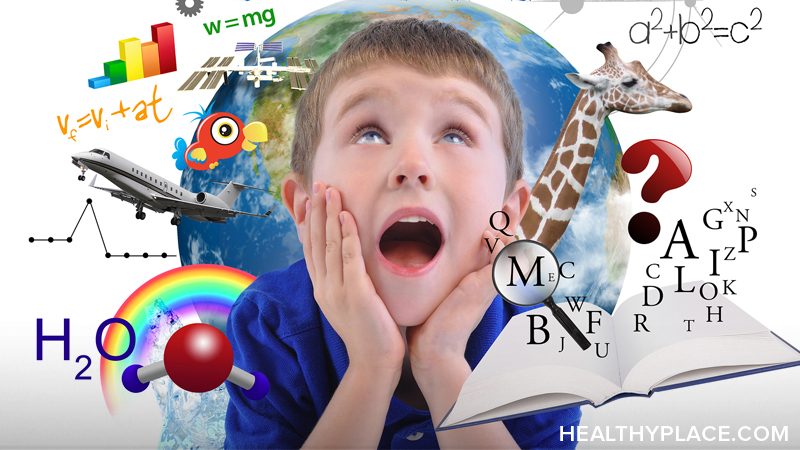(Don't leave home without them!)
It's not difficult to address your child's needs at an Individualized Education Plan (IEP) meeting, so long as you're thoroughly prepared. Learn all you can about ADHD and any learning disabilities involved. Do some reading and research on what interventions are likely to produce positive results.
If you believe your child's disability seriously impacts academic success, you have the right to ask, in writing, for a full educational evaluation. If your child qualifies, then special services can be provided. If the qualification falls under the Individuals with Disabilities Act, then your child will have a written Individualized Education Plan, or IEP, prepared for him/her.
A team, comprised of various school officials, experts, and you will prepare the IEP. As parents, you are members of that team and your opinion is as important as any other team member. In fact, the federal government acknowledges, you are truly the expert on your child with knowledge no one else has. Go to the table well-informed and ready to lay some options of your own. Know what can work and decide what options won't be acceptable. Then review your child's evaluations and prepare to write a parent attachment. Normally, you'll request an opportunity to read this attachment at the beginning of the IEP meeting.
Understand your child's last multi-evaluation results.
Assuming your child has already been tested for the level of his learning skills, it's important for you to understand what those scores actually mean. If you need help with that, here's an excellent article on the subject.
Don't pay attention to "composite" scores, or "averages". With disabilities, you need to be concerned about scattered, or individual, scores. Pay attention to every low score. Even if you don't understand everything about every subtest, write down all those low scores and your questions about each one. "What does this particular test measure? What does that result mean to my Johnny and his teacher in the classroom? What is the likely impact?" Again, do not be distracted by discussions of "averages".
The First Document: Write your own version of your child's PLPs or Present Levels of Performance.
Get out the last Individualized Education Plan, or IEP, and place it next to the evaluation. Is every need in the evaluation reflected in the IEP? Are the recommendations in the evaluation reflected in the IEP? Now--after taking a minute for gnashing your teeth and groaning, it's time to get to work fixing things up.
Hopefully, you're familiar with the term "Present Level of Educational Performance" or PLP or PLOP. It describes, in measurable terms, where your child is performing in his/her areas of need. Those measurements are usually scattered throughout an IEP and are sometimes subjective.
I was especially impressed (cynicism here) with the PLP that read "Johnny's English is better. He's doing real good." If your child's performance in any area can't be measured in numbers, it's subjective. Make sure the evaluation comments are measurable and written into the PLP in all areas where special ed help is needed. If the school hasn't given you more recent objective,measurable, information, take the measurements from the last evaluation. Go to the meeting with the same kind of measurable information you expect from the school.
The U.S. Dept of Ed has demonstrated an alternative way of writing PLP's.
I tried it and was amazed at how it kept parents, and the rest of the team, focused on the whole child and his/her needs. While the district writes the actual PLP, you can certainly write your own and just call it A Picture of Joanie, for example. I recommend this description be at the very top of the parent attachment.
Try writing a long narrative about your child.
Take pen in hand, think about your daughter or son, get a picture in your mind, and start writing. Describe his/her disposition, personality, (shy or out-going, laid-back or sensitive, etc.), likes, dislikes, sensitivities, medical conditions that impact education, and level of self-esteem. Work in those measurable test results, showing a need for help in those areas.
Write about the strengths, be they in art, hands-on mechanical skills, writing, storytelling, etc. End with the dreams of where your child sees him/herself in 10-15 years; whether college is in those dreams, or a vocational-technical school, or if there's a need to get training out in the community while still in high school. You'd be surprised at the answers even second grade children with disabilities give to these questions. They can show great faith in the future, and sometimes awesome maturity at a tender age.
Now see if you can whittle those three pages down to one. Stick to the basics, other than one good emotional paragraph because, after all, you ARE the mom or dad and your emotional feelings can have an impact on the rest of the team members.
Come on, give it a try. Usually, parents really enjoy this exercise once they start writing. When finished, you'll have the first of the two documents completed. And, oh yes, don't forget to attach a picture of your child. That way, team members remember they aren't just dealing with a black-and-white sheet of paper, but a real, live human-being.
The second document is what I call a Parent Attachment. This document reflects all your specific concerns and your judgment of what your child needs. The plain truth is, if you're having to resort to these strategies, obviously your district hasn't served your child's needs. So it's important to get this down in writing.
I find that when a parent is well-informed about what's needed, it's much easier to get those needs met. It shouldn't be that way, but I understand the reality out there in many situations. Frequently, if the school doesn't point out a need, it's not going to be in the IEP. Hopefully, you'll have done some research on what can help your child's particular disabilities. With access to the net, an abundance information is now available.
Title
The following brief example is just to give you the idea of how these documents work together.
"A Picture of Joanie:" Your own PLP
Joan is a happy, outgoing, 12 year old with an average I.Q. and a tremendous interest in art and a great love of animals. She attends to tasks reasonably well, and takes pride in a job well done. She has acceptable fine motor control, but does have serious difficulty with large motor control. Her awkwardness has caused her embarrassment in front of her peers who do not appear to understand her disabilities.
Her self-esteem is quite low and she worries about people staring at her. She's performing at the 4th grade level in math, having made a whole year's progress this year with the extra teacher assistance and computer-assisted assignments.
Her reading level is at 2nd grade level, with difficulties in decoding, encoding, but some strength in comprehension. She particularly enjoys social studies because there's more movement and less paperwork than in other classes. With more hands-on activities, she's not so pressured by her deficit in reading.
Oral assignments and oral tests have encouraged her also. Joanie dreams of one day owning her own car, having a job, and moving to an apartment. She would like to volunteer at a zoo and work with animals when she's grown up. She dreams of going to college and getting a degree in animal husbandry.
Sample Parent Attachment
Joan Doe's IEP Meeting, (Date)
These are our concerns regarding our daughter's education:
-
Joan's walking gait causes numerous problems physically. Request physical therapy continue, at least 1/2 hr./week.
-
Her self-esteem is poor, and we request special emphasis be placed on her area of strength which is art. We request the district actively support a mentorship for her next year in this area, either in school or in the community. We will support that program in any way we can.
-
We also request a counselor who can help Joan deal with peer teasing. Her obvious reading deficit also sets her apart from peers. We are asking for intensive instruction by a teacher trained in multi-sensory teaching who can help Joan make true progress in reading. If the district doesn't have someone with these qualifications, we ask the district to provide a qualified tutor to teach her reading during the school day.
-
We would like to offer our assistance in helping to put on a seminar for the whole student body on disability sensitivity. Public education will hopefully build support for Joanie and others with disabilities.
-
Joan's learning style is both visual and kinesthetic; however, we have yet to see these methods intensively employed in teaching her. Joan does learn differently, but she's entitled to a teacher who knows how to reach her. Multi-sensory teaching is good for all students and we believe it's a reasonable request and necessary for her academic success.
-
Joan's I.Q. is in the average range and there's no excuse for her not to be making measurable, substantial progress. We expect all short-term objectives will be tested with measurable instruments and progress will be reported to us on a quarterly basis. We are willing to take responsibility for reminding the teachers of these meeting dates.
-
Homework may need modification if the time involved is more than 1 1/2 hours a night.
Get the idea? Now you can go into the meeting armed with both a total picture of your child, reflecting all the strengths and needs. You also have a written list of requests that you have pondered over and had plenty of time to work on in an unpressured, non-stressful environment. You'll feel much more in control, as you can focus on these two papers in front of you. Be sure to ask the leader of the meeting, before it starts, to let you lead off by reading your Parent Attachment. Otherwise, it can get lost in the shuffle. Once you read it out loud, and every person has a copy in front of him, you can always come back to it later on.
Do not sign anything, or leave the meeting, until you can check off every point you have written down. Was each item addressed? Was a decision made regarding each item?
Sometimes, one of your items becomes moot when something grand and wonderful happens, and you can actually cross it off and initial as "no longer needed". (Yes, I actually see that happen.) In fact, once you start using this method you'll likely see a lot less resistance than before. These poor folks often see "irate" parents, and they know how to handle that, because an irate parent is not in control of the situation. When you can come into the meeting with your priorities written down in a businesslike manner, then you'll begin to feel in control and will know you are a driving force at that meeting.
next: Different Types of Educational Assessment Tests
~ back to Parent Advocate homepage
~ adhd library articles
~ all add/adhd articles

 Use of the attention deficit/hyperactivity disorder (ADHD) drug
Use of the attention deficit/hyperactivity disorder (ADHD) drug  The depression symptoms listed here, may signal that you, or someone you love may be depressed.
The depression symptoms listed here, may signal that you, or someone you love may be depressed. One prominent theory is that the relationship between ADHD and depression may result from the social/interpersonal difficulties that many children with ADHD experience. These difficulties can lead important others in the child's life to develop negative appraisals of the child's social competence that are communicated to the child during the course of ongoing negative social exchanges. With increasing age, these negative social experiences and others' negative appraisals can adversely affect children's view of their social competence, which, in turn, can predispose them to develop depressive symptoms. An interesting study published in the Journal of Abnormal Child Psychology was designed to test this theory (Ostrander, Crystal, & August [2006]. Attention Deficit-Hyperactivity Disorder, Depression, and Self- and Other Assessments of Social Competence: A Developmental Study. JACP, 34, 773-787.
One prominent theory is that the relationship between ADHD and depression may result from the social/interpersonal difficulties that many children with ADHD experience. These difficulties can lead important others in the child's life to develop negative appraisals of the child's social competence that are communicated to the child during the course of ongoing negative social exchanges. With increasing age, these negative social experiences and others' negative appraisals can adversely affect children's view of their social competence, which, in turn, can predispose them to develop depressive symptoms. An interesting study published in the Journal of Abnormal Child Psychology was designed to test this theory (Ostrander, Crystal, & August [2006]. Attention Deficit-Hyperactivity Disorder, Depression, and Self- and Other Assessments of Social Competence: A Developmental Study. JACP, 34, 773-787. Let us get rid of some myths about depression right away. Depression is not a sign of weakness. It is not a lack of character or courage. Abraham Lincoln and Winston Churchill are two of the many historic figures known to have suffered from serious depression. Well-known and highly respected figures from all walks of life are among the millions of people who experience depression.
Let us get rid of some myths about depression right away. Depression is not a sign of weakness. It is not a lack of character or courage. Abraham Lincoln and Winston Churchill are two of the many historic figures known to have suffered from serious depression. Well-known and highly respected figures from all walks of life are among the millions of people who experience depression. Though the term "depression" can describe a normal human emotion, it also can refer to a mental health illness. Depressive illness in children and teens is defined when the feelings of depression persist and interfere with a child or adolescent's ability to function.
Though the term "depression" can describe a normal human emotion, it also can refer to a mental health illness. Depressive illness in children and teens is defined when the feelings of depression persist and interfere with a child or adolescent's ability to function. A. The relationship between attention deficit hyperactivity disorder (ADHD) and bipolar disorder is not quite clear. There have been some studies showing no relationship, others showing that bipolar disorder is unusually common in children or adolescents with ADHD. There are also some individuals who, by the luck of the draw, end up with both disorders -- a state termed "comorbidity." This refers to the chance occurrence of two conditions, without implying any genetic or physiologic similarity. Some clinicians have speculated that ADHD is a kind of "precursor" to later development of bipolar disorder, but this has not been proven. There is some symptomatic overlap between ADHD and individuals with hypomanic symptoms, such as unusual amounts of motor activity and tendency to be overexcited and "rub people the wrong way."
A. The relationship between attention deficit hyperactivity disorder (ADHD) and bipolar disorder is not quite clear. There have been some studies showing no relationship, others showing that bipolar disorder is unusually common in children or adolescents with ADHD. There are also some individuals who, by the luck of the draw, end up with both disorders -- a state termed "comorbidity." This refers to the chance occurrence of two conditions, without implying any genetic or physiologic similarity. Some clinicians have speculated that ADHD is a kind of "precursor" to later development of bipolar disorder, but this has not been proven. There is some symptomatic overlap between ADHD and individuals with hypomanic symptoms, such as unusual amounts of motor activity and tendency to be overexcited and "rub people the wrong way."